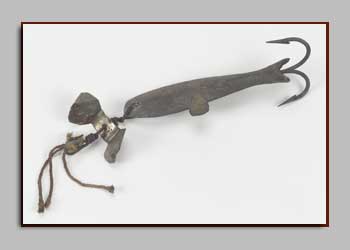Fishing
 Wood, boughs, bark, and roots furnished Makahs with raw material not only for household goods, but also for fishing and hunting equipment. Ozette has safeguarded such gear from the prehistoric past, and the ancient designs are so perfected that today's Makah elders recognize most of them. They used similar equipment well into the 20th century. Indeed, some of the gear still hasn't changed. Modern halibut hooks, for instance, are the same shape as the Ozette hooks, and act the same way in the water. Only the materials are different.
Wood, boughs, bark, and roots furnished Makahs with raw material not only for household goods, but also for fishing and hunting equipment. Ozette has safeguarded such gear from the prehistoric past, and the ancient designs are so perfected that today's Makah elders recognize most of them. They used similar equipment well into the 20th century. Indeed, some of the gear still hasn't changed. Modern halibut hooks, for instance, are the same shape as the Ozette hooks, and act the same way in the water. Only the materials are different.
Halibut were a mainstay for Makahs, available year-round. Constantly bringing the fish in, men kept track of which feeding banks they were using, and so could find them at any time. Women filleted the flesh, then dried the pieces and stored them in openwork baskets, which provided ventilation. Poles from roof racks for drying halibut lay with the planks of the Ozette houses.
Salmon came seasonally, swimming through Makah salt water to start their freshwater runs in the rivers and streams of the Strait of Juan de Fuca and the Pacific Ocean. Makah rivers also drew spawners. At Hoko River, archeological excavations have yielded hooks and nets 2,600 years old. Depending on location, salmon were caught by hooking, harpooning, or shooting with arrows. In places latticework weirs acted as obstructions, concentrating the fish and making them easier to catch.
Herring and smelt came to the sandy beaches. The herring were caught on the bone points of rakes swept through the shallow water. Smelt were taken in fine-mesh dip nets. The nets are of particular interest, for they take a great deal of time and energy to make, and require careful drying and storing to prevent rot.
Ling cod and bass prefer rocky places. The lingcod could be lured to the surface from the shallow bottom where they spawned and took up guard to protect their eggs. At the surface they were speared.
^ top

